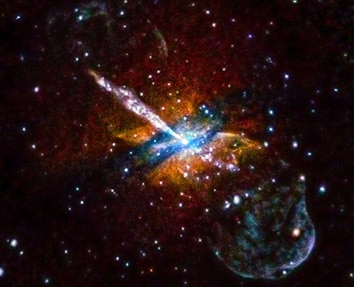Create a free profile to get unlimited access to exclusive videos, sweepstakes, and more!
X-Raying a Monster Black Hole

Every now and again an astronomical image will be released, and when I look at it I just go, “Huh?” It takes me a second to understand what I’m seeing, and when that happens, it’s always both surprising and awe-inducing.
In this case, the cosmic target is one perhaps familiar to regular readers: the nearby active galaxy Centaurus A.
The image is from the Chandra X-ray Observatory, one of NASA’s Great Observatories—think of it as Hubble for X-rays. Chandra has been observing Cen A closely for years. In fact, this image is a combination of observations taken during a 14-year period starting in 1999—a total exposure time of an astonishing 800,000 seconds. That’s over nine solid days!
X-rays are a high-energy form of light, and it takes a lot of energy to create them. In the very heart of Cen A is a supermassive black hole, one with more than 50 million times the Sun’s mass (compare that to our Milky Way galaxy’s black hole, a “mere” 4 million times more massive than our Sun).
Black holes like this can be the source of huge amounts of power. Material like gas and dust can fall toward the hole, forming a vast disk of material that gets heated to terrifying temperatures by friction and other forces. Magnetic field lines twisting into coils can then launch twin beams of energy away from the black hole, dragging matter along with them. These beams blast outward at a very high speed, which then slams them into material inside and outside the galaxy.
That’s what you’re seeing here. The bright dot in the center is from X-rays booming out of the disk around the black hole. The beams are easy to spot, too. The one to the upper left is headed more or less in our direction. Because it’s moving so quickly, the beam gets its light amplified by relativistic effects. That likewise dims the beam moving in the opposite direction, making it fainter. Both are emitting copious amounts of X-rays.
I love that bubble of material to the lower right. That’s where the beam is slamming into material, which is expanding away in a vast wave. That’s a bit more clear when you look at the galaxy using submillimeter waves (between infrared and radio waves in the spectrum; this image also has X-rays in blue and visible light, too):
As you can see, the structure of the beams is a bit more complicated than you might first think. After they ram enough material they slow down and expand, forming those huge lobes. Sometimes the lobes point in opposite directions; that can be due to the galaxy’s motion, or the beams slowly moving around as the disk precesses (wobbles) over time.
The galaxy itself glows softly in X-rays (lower energy X–rays are shown in red, medium in green, and high-energy in blue). This is from various objects like supernovae, hot gas, star-forming regions, and more.
The X-ray image shows a broad gap across the galaxy’s middle, which is even more obvious in the submillimeter image. That is a vast swath of dust orbiting around the galaxy, almost certainly stripped from a smaller galaxy during a collision. Cen A is in the process of eating the smaller galaxy! That’s probably what is fueling the material falling down into the black hole as well.
So all of this weirdness is most likely due to the collision: the bright central source, the jets, the bubble, and the swoosh of dust. You are what you eat.
Cen A is pretty close, about 12 million light years, and is one of the brightest galaxies in the sky. As the closest active galaxy (one with a bright central black hole actively devouring material), it’s very well studied. And that’s what caused my momentary confusion when I first saw this image. I knew it was in X-rays, but I assumed that it was a composite of X-rays and visible light, and the structure I saw in the image is not at all what I’m used to seeing. The colors, the shape, even the “texture” of the image looked off to me. It wasn’t until I read that the image is only showing X-rays that it made sense in my head.
And then the wave of awe struck me. X-rays are very difficult to detect, and sources are generally not that bright. To see this kind of detail in an X-ray image is astonishing, and over such a large area of the sky, is nothing short of exceptional. This is a phenomenal image, digging incredibly deep into the galaxy structure.
When you combine it with other deep images (even ones taken by amateurs) a lot can be learned; different mechanisms produce different kinds of light, revealing more about the physics going on behind the scenes. Active galaxies are very bright and can be seen for billions of light years; having one this close is a gift to astronomy.
And to our eyes and brains, too. I never get tired of how such amazing objects are also so beautiful. It does make them more pleasurable to study, even if they weren’t so magnificently interesting on their own.


























